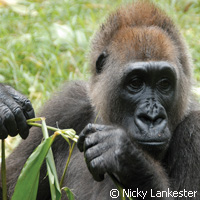Sophisticated technology sheds light on divergences of great ape populations
Central equatorial Africa is home to two gorilla species: eastern gorillas (Gorilla beringei) and western gorillas (Gorilla gorilla). The distance between both species is not great following their divergence, which began between 0.9 and 1.6 million years ago. New international research has discovered that the divergence of western lowland gorillas and the critically endangered Cross River gorillas (Gorilla gorilla diehli) transpired only almost 18,000 years ago, during the Pleistocene era. The results of the study are presented in the journal BMC Evolutionary Biology. Many of our planet's large mammals live in small, fragmented populations, and researchers have wondered whether this subdivision was triggered by recent or long-term events. Genetic data-generated demographic modelling could help scientists estimate changes in long-term population sizes while temporal sampling enables them to compare genetic variation between new and old samples. Researchers from Finland, Germany, Switzerland and the US produced a sophistical model of the two subspecies of western gorillas using microsatellite genotyping of living gorillas and century-old museum specimens in order to provide insight into the dynamics linked to the divergences of great ape populations, and specifically between western gorillas and the Cross River gorillas. Their data show that the two subspecies interbred intermittently despite having diverged around 17,800 years ago. Lead author Dr Olaf Thalmann from the Department of Biology at the University of Turku in Finland, along with colleagues proposed that climate change during the Pleistocene era triggered the expansion of the forest, allowing the western gorillas to expand their range. The gorillas then split into two populations which began to diverge when the forest re-contracted. They say successive rounds of climate change resulted in periods when the two subspecies could interbreed followed by repeated episodes of isolation of the Cross River population. Their findings show that gene flow ceased between the two subspecies around 420 years ago, and a 60% drop in the Cross River gorillas resulted over the last 320 years, resulting in a loss of genetic diversity within the population. 'We find that Cross River gorillas diverged from the ancestral western gorilla population around 17,800 years ago,' the authors write. 'However, gene flow ceased only around 420 years ago, followed by a bottleneck beginning around 320 years ago that caused a 60% decrease in the effective population size of Cross River gorillas. Direct comparison of heterozygosity estimates from museum and contemporary samples suggests a loss of genetic variation over the last 100 years.' Dr Thalmann points out that human activity, including hunting or habitat destruction, is putting a great deal of pressure on the Cross River gorillas, compelling scientists to believe that less than 300 Cross River gorillas exist today. 'It is unclear what effect this loss of genetic diversity will have on the long term viability of Cross River gorillas,' says Dr Thalmann, 'but, given that this bottleneck occurred so recently, it is possible that if the population was allowed to expand the loss of diversity could be stopped.' Researchers from the Max Planck Institute for Evolutionary Anthropology in Germany, the Université de Fribourg in Switzerland and the University of California Los Angeles (UCLA) as well as the North Carolina Zoological Park in the US contributed to this study.For more information, please visit: University of Turku: http://www.utu.fi/en/ Max Planck Institute for Evolutionary Anthropology: http://www.eva.mpg.de/english/index.htm BMC Evolutionary Biology: http://www.biomedcentral.com/bmcevolbiol/
Countries
Switzerland, Germany, Finland, United States



